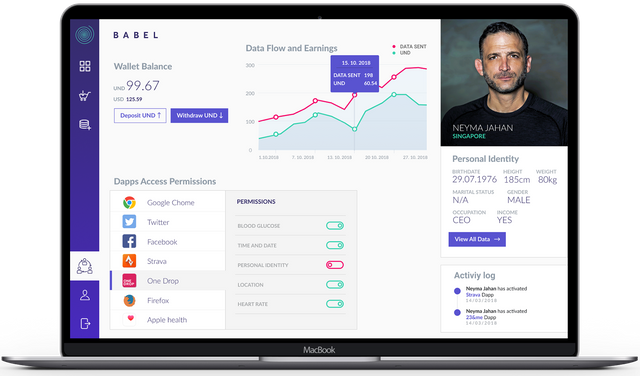Your Data is part of a billion dollar market, but you're not even getting a cent.

Decentralized applications are witnessing a growth in adoption, but the impeccably slow rate of their usage is an incredible injustice to blockchain technology.
The key issues faced by distributed ledger technologies, particularly those applying smart contracts, is that they require external entities to mold their systems to meet the demands of the blockchain. However, most users are far too accustomed to the conveniences and familiarity of their current applications that they are unwilling to adopt decentralized applications at scale.
Enterprises, on the other hand, are typically an easier sell as their primary focus is on the bottom line rather than convenience. However, familiarity plays a role even here as synchronization is a key hurdle when it comes to adoption of blockchain technology by enterprises. Companies have well-established technology stacks that are, typically, operating in harmony. Integration of DLTs forces them to restructure their systems from the ground up, and this is an expensive leap most enterprises are unwilling to take.
The solution to large-scale utilization of decentralized applications lies in easing the process of integrating blockchain into the costly systems enterprises have already set up.
A Proper Solution
Major technological and financial firms have invested initial resources to research the benefits of blockchain technology. While this may not be a testament to a desire to adopt decentralized networks, it is evidence of interest. This is the key starting point.
A new blockchain development, Unification, aims to convert this interest into legitimate adoption of DLTs by making the process a logical decision rather than a burden. Unification aims to achieve this by ensuring its developments can be seamlessly integrated into existing tech stacks. This provision makes the adoption of blockchain solutions conveniently integrated into the systems that the institutional decision makers and work force participants are familiar with.
This article is quite a long read. If you prefer visual content, you can use the following video to get a deep grasp of Unification aims to turn data into a liquid asset through the benefits of blockchain technology.
The Vision
Unification has envisioned a future where data is an asset class and DLTs are a core technology that adds tangible value to software, applications, and decentralized applications. To achieve this, Unification fulfills three key needs of adoption:
Seamless
Unification’s technology can be integrated into not just enterprise SaaS, but into websites, applications, and decentralized applications. Through the use of one of its core offerings, HAIKU, Unification is able to turn siloed technologies into well-connected networks that are part of a larger inter-linked technological ecosystem.
Thus, HAIKU allows Unification to integrate blockchain-enabled benefits into various existing technologies. This leads to the creation of Unified Apps (UApps).
The creation of UApps allows enterprises to leverage other benefits, particularly Unification’s goal of making data a highly liquid asset. This will be discussed in greater detail later in the article.
The following graphic breaks down the data ecosystem Unification is making:
Example: I use Samsung’s in-built health app which tracks my sleep. The app also tracks my daily activity, calorie burn, steps walked, and a host of other things. Collectively, this is a high-quality dataset because Samsung is able to connect all this data with all the other data points collected through my phone activity.

Easy
One of the issues of blockchain technology is that current offerings require enterprises system to adopt raw technological solutions. While the related work force may be trained to grasp the new UIs and input commands, the wider consumer market would be unwilling to accept such a shift.
Thus, Unification ensures that user-end experiences are not tarnished for the sake of providing blockchain-enabled benefits. In fact, Unification provides facilitations to boost user experiences. Primary examples of this are that Unification will allow websites, applications, and decentralized applications—collectively, Unified Apps—to easily make cryptocurrency payments on existing gateways. This creates for a seamless shift from existing user experiences to a newer, better user experience which sustains the familiarity and convenience that users innately seek.

Secure
Security is one of the foundational benefits of blockchain technology. The present focus on uplifting security and enabling its provision at all costs makes distributed ledger technologies meaningful for payment systems, but less applicable in the smart economies as had been hoped by blockchain 2.0 developments.
However, Unification has developed a means to sustain security without compromising convenience and scalability. Unification has created CAPSULEs for data.
A CAPSULE serves as a technological packaging unit for various data. This development coincides with HAIKU to ensure that seamlessness is retained in the UApps and familiarity is sustained on the user-side without data security being sacrificed. Codes built into smart contracts decide the rights of access to data as permissioned by users—code is law.
CAPSULEs are accompanied with SDKs that allow developers to integrate data flow cohesively across the Unified Apps.
Accessibility
The current distribution networks for applications are unsuitable for decentralized applications. App marketplaces like the Play Store and or the App Store, after some hassle, allow decentralized applications to list themselves. However, listing on such app marketplaces nullifies the very reason decentralized applications are created.

Established app marketplaces retain data in centralized storages and store user information while giving them limited rights of permissioning its use.
Unification, thus, is creating an app marketplace designed to support Unified Apps, making the distribution channel of the UApps as accessible as the established app marketplace. Yet, this accessibility will not come at the cost of dissuaded rights to the users. BABEL will uphold the values that underpin the security and liberty aspects of decentralized applications. BABEL will provide various native features:
Wallet
To ensure minimal frictions in the user experience and transactional throughput of the Unification ecosystem and the UApp network, BABEL will provide users with a native, secure wallet that will allow them to access the UApp marketplace and make purchases at will. Such a user experience will be familiar to the app acquisition interactions users (and even enterprises) are adjusted to.
The localization of the wallet, though, will mark a key difference between the UApp marketplace and current app marketplaces, which rely on external payment channels, such as payment cards, to process value transfer. BABEL will cut out middlemen which limit the earnings of developers and will directly connect users with the buidlers.
Marketplace
BABEL will enable UApp developers to reach the masses without forfeiting extensive rights over their development, as is the norm with present app marketplaces. The provision of a marketplace ensures the efforts of developers are focused on creating innovative solutions and desirable applications rather than attracting an audience.
At present, a vast portion of decentralized applications, irrespective of the novelty and quality of their development, are not able to access app marketplaces as their developers do not want to tarnish their work by placing the access of the DApp on a centralized platform. Thus, developers must exercise great efforts to attract users by internal marketing. A marketplace that supports the core aspects of the decentralization movement ensures the talent of developers is properly utilized for the primary development of UApps rather than their marketing.
Identity Center & Data Clearance
BABEL will allow end users to manage their CAPSULEs and to see the UApps that have access to them. Thus, BABEL brings all the user’s identity-related permissions into one convenient frame. Through this dashboard, users can control, edit, add, and remove permissioned access to their data and even control the basis of the permissioned data access.

Users who are willing to provide their data for value transfer will be able to do so. As BABEL has an in-built wallet, it will support the native trade of data. Enterprises, researchers, and all other data consumers will be able to directly pay people for their data. This greatly improves users control over their data and ensures their information is kept out of the hands of nefarious entities.
Additionally, BABEL’s ability to support a user-centric data clearinghouse is that the quality of data will be greatly enhanced and users will finally access a slice of the data market. In this mutually beneficial interaction, data consumers will receive high-quality data directly from the users; with the removal of data delivery agencies, middleman fees will be removed and would thereby make the functioning of data-heavy operations more affordable. The funds that will be paid would be directly given to everyday individuals, thereby finally allowing the masses to share in the billions that float in the data industry.
Data Liquidity
Unification provides a complete suite of solutions to enterprises that intend to integrate DLTs and to users who seek to conveniently access decentralized applications. As HAIKU serves as a connecting protocol, it connects the data flows of siloed developments—websites, applications, decentralized applications, etc.—through data CAPSULEs.

The CAPSULEs effectively tokenize the aggregate data of users across their digital lifestyle. This gives users an easy way to control the data’s security and permissioned access, which includes its purchase and trade.
Demand for Data
Major technological improvements in machine learning and AI are enabled through data. Enhancements in drugs, healthcare techniques, and drug use are made possible through the research and analysis of immense volume of data. Corporate ventures, too, rely on data to ensure efficient operations that sustain lean inventories while maintaining up to the trends of the consumer market. Companies across the world are in a constant need of data and, if data becomes permissioned, there will be an imminent need to provide liquidity to this market.
Liquidity, in this scenario, means a feasible channel to purchase large volumes of data at its proper market valuation.
Unification makes it possible for enterprises to integrate DLTs into their systems, thereby enabling them to easily access data that requires permissions from users. At the same time, the tokenization of data will attach a tangible price to it and the BABEL interface will provide the wallet and easy flow of the data.
This ensures that data can be bought and sold with immense ease, with the proper rights of access from those who own the data.

DLTs and data markets are a new and highly valuable resource in this ever-competitive world. Unification is making it possible to integrate DLTs into existing infrastructures while ensuring users gain the benefits of decentralization. However, specific services in Unification’s development portfolio will ensure decentralization does not limit the growth of today’s data-reliant commercial and technological operations. Instead, it ensures the data market gathers greater liquidity than ever before while remaining secure and GDPR-compliant.
Potential Major Use Case
Additionally, given that Unification allows developers to create UApps that can benefit from other protocols Unification is creating, BABEL could be the key means to distribute the new generation of exchanges, designed for the trade of tokenized data, in the form of CAPSULEs. These data pellets would allow users to organize their digital life into an easily manageable package. Portions or the entire volume of data held in the CAPSULE could be auctioned, placed in order books, or traded on the potentially revolutionary exchanges that could be created upon Unification’s technology and distributed through BABEL.
A Deeper Look
Tokenization has changed the dynamic of software sales.
People can now directly buy and sell tokens, which grant access to decentralized software, over exchanges. Traditionally, only licensed wholesalers and retailers sold software licenses. Unification can make it possible to create the same trade token systems be effectively applicable for data. The development gives people control over their data, including the ability to sell it directly to data consumers. However, people are not going to go out and scout data buyers nor would companies want to buy data from individuals.
Thus, the largest selling power would be with the apps that collect. They will sell it, but with people’s permission. Though, it doesn’t need to be this was as data consumers purchase directly from people can be made extremely easy and efficient.

Data exchanges can be created for entire capsules. As, HAIKU allows the organization of data through headers, data buyers could limit the purchase of the data CAPSULEs they want to buy on exchanges. Right now, we can use digital asset exchanges to buy tokens of different companies. We could, soon, instead use the infrastructure of digital asset exchanges to buy data CAPSULEs of people of specific ages from specific locations.
Given that there’s a finite number of countries and a finite number of reasonable age groups to buy data from, a digital asset market for the data CAPSULE of every age from every single country can be created. While the product of 200 countries and 80 age figures, which is 16,000 markets, may seem too large during the onset of such a data trade system, it provides a vision for what can be achieved in the future. During the earlier days, markets for age groups and large regional covers can be created.
Here's a video to get a deeper grasp of this concept.
Development Progress
Unification is a development led by professionals with a deep insight in the software and data industries. The key development roles are fulfilled by talented individuals with past experiences from major technology firms like Zynga and Yahoo. Meanwhile, the business side of the project is handled by an ex-Ripple business development officer.
The project has delivered its pitch at various major blockchain exhibitions across the world, and it even utilized these events to display the functionality of BABEL.

Given that Unification is part of a select few ICOs that involve a functioning product, the project has quickly attracted an array of institutional investors and partnerships, including Esoteric, Alpha Chain, HINT Chain, and more. While the development process is on an incredible track, the project’s community growth is logically planned to ensure to utilize traditional marketing methods of the decentralized community, but with necessary improvements.
Unification is one of the few projects that hosted an airdrop that will issue tokens for utility on the technology suite rather than a sellable asset in the wallets.
This shows that the project truly recognizes the purpose of tokens: means to access software. An airdrop simply serves as a limited term provision to a software to allow users to test it; this is similar to free limited term access to services new users receive within the existing service sector.
This move shows that the project’s founding team is genuinely aware of the Crypto space and intends to provide valuable resources to the blockchain space without making the mistakes (and abuses) made by their predecessors.
On a closing note, it's worth mentioning that Unification will be the technology, blockchain, and protocol layer for the data ecosystem its founders have envisioned. This will enable others, ergo the community, to utilize Unification's development and integrate it into their own applications, DApps, software, etc. Entirely new UApps could be built atop Unification's infrastructure. This ensures the democratizatin of the data economy remains in the hands of the community.
Essential Links
🌐 Website: https://unification.com/
💡 Whitepaper: http://go.unification.com/whitepaper
💻 Telegram: https://t.me/unificationfoundation
Connect with me:
Bitcoin News Crypto Airdrops ICO List
Blockchain Lawyers ICO Lawyers








Interesting.... I think INSolar has something similar going on...
well this is right but when you speak about implementing dezentralized systems ... there are non at scale.
fully dezentralised systems are Bitcoin and Ethereum...who should implement them? they are not far away from a proof of concept.
If you mean more centralised, consortium chains or even private chains then this reduces the set of use cases to a small subset.
Due to that, Unification is creating its own blockchain dedicated to the data ecosystem. It will also provide generalized state channels to facilitate scalability.
buen bien
Data will be worth more when we fully embrace IoT, I have covered some ICO that are using blockchain solutions affecting current monopolized state of Data Market.
Thank-You for highlighting Unification project @hatu Will research more on the project.
Posted using Partiko iOS
Thank you, James. I will look into some of your work.
Reading this post sound pretty interesting I guess I can't wait for unification to commences
It certainly does seem quite exciting.
Don't you mean commence?
To listen to the audio version of this article click on the play image.

Brought to you by @tts. If you find it useful please consider upvoting this reply.
Great post. Absolutely! When you're not the customer you are the product.
Yes; an often overlooked reality.
Okaaaaaay!I can’t get with this!
Posted using Partiko iOS
You can definitely get with this. :)
The goal is to deliver the technology to you seamlessly via SDKs held in your apps.
Here's an example of the flow of data and UND in the ecosystem:
True we didn't get anything
Posted using Partiko Android
However, it can now be changed.
Saludos @hatu! Muy completo tu informe, gracias por compartir la tendencia. En definitiva el negocio esta en la capacidad de manejar e interpretar los datos, a través del diseño y utilización de herramientas eficientes.
It's why Facebook and google are worth so much, because of their data. They have data on anyone who has ever visited their sites because of pixels. This piece of code tracks all of your movement throughout the internet with or without your concern. Using this data they sell it to advertisers. It's why merchants and advertisers love them because they can target users based on interest and demographics. Also create audiences called lookalikes and target people similar to their customers and retarget people who visited their websites because they have pixels installed on their sites as well. It's all about data in this day and age
Very well said!
You covered the depths of data's role in the marketing industry.